I’ve written a number of posts over the years of about our frustrations with trying to grow fruit trees, and vegetables, under tremendous deer pressure. I never expected to write a post about a paucity of deer on the farm.
Usually we’re posting about deer that have raided the orchard, repeatedly, and the kitchen garden. But this year, something has changed.
The honest truth is, despite the occasional frustration at nibbled fruit trees, and devoured cucumbers, I love looking outside the window in spring, and seeing young fawns playing, and deer grazing on the grass, just outside the window. The wildlife here can travel through the farm and surrounding woodland unencumbered, and that makes this farm that much more special. I’ve worked with wildlife in a professional capacity for more than 20 years now, and I’m proud of the fact that we raise livestock here, and grow fruits, and vegetables, without restricting the wildlife species that reside here.


Since moving to Curbstone Valley almost eight years ago, and working here on the farm almost every day, I’ve come to know our resident deer herd very well. We’d observe the bucks in the fall, but from late winter through early fall, we’d mostly observe the does, with their yearlings, and fawns, traveling through the farm on an almost daily basis.
However, three plus years of drought, and predators, have changed the deer population here on the farm significantly, and most notably during the course of this year.
When we first moved to the farm, the deer here were abundant, but always seemed to be part of the same large family group. Many were readily recognizable due to distinguishing coat features, or old scars, and wounds.
Looking out of our bedroom window in late winter this year I was surprised to see an old friend. A grey, grizzled doe that we’d nicknamed ‘Grandma’ looking back at me from the garden. I was amazed to see she had survived yet another winter, especially as we’d had an extended cold snap last December. I’d seen ‘Grandma’ every year since we moved to the farm, often with her daughters, and presumably her granddaughters. Late this winter though she was clearly showing her age, and she looked cachectic, and frail, standing and grazing in the sun. I often wondered how old she was, and how long she’d called the farm home, but that was the last I saw her.
The next most senior doe in the herd was ‘Split Ear’. We’ve seen her every year we’ve lived on the farm, too. She always looked like she’d a have a lot of stories to tell if she should speak. Each spring she’d bring her fawns, usually twins, to graze near the poultry pens. She was clearly a hardy doe, and perhaps largely responsible for the sizable, and healthy herd that was here when we arrived.
Then last year, perhaps due to her own advancing age, she only had a single fawn, that we nicknamed, a very unoriginal, ‘Junior’.
We saw Junior still traveling with her in early spring this year, until one afternoon I found him wandering through the farm, crying out, quite loudly, as he walked the hillsides near the house. It’s not unusual for does to leave their offspring for extended periods, but this time his cries seemed ominous, and were still unanswered by late that afternoon.

If he was still alone at sun-down, I intended to notify a local wildlife rescue group, but he walked back through the ravine behind the buck pen before dusk, and that was the last we ever saw of him. We haven’t seen ‘Split Ear’ since our last spring encounter, either, and presume she’s also gone.
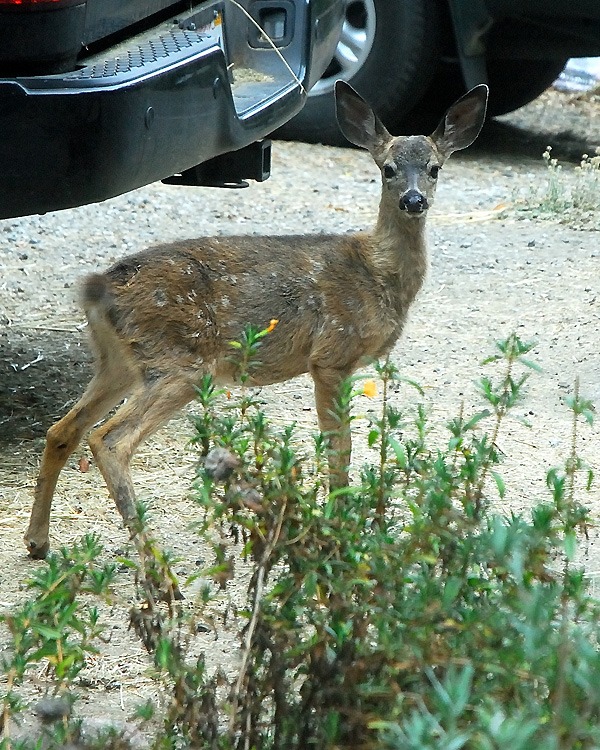
After not observing any deer on the farm through the rest of spring, in mid-summer a single doe, with a single late-born fawn, showed up at the fountain. This particular pair were observed daily this summer drinking from the fountain rock in the native garden in front of the house that we’d originally installed for the bees.
This year a variety of birds, including wild turkeys, and these two deer, seemed to depend on this last remaining reliable water source on the farm. This doe, her fawn, and a single young buck have been the only deer sighted on the farm since March. We’ve never seen so few deer as we’ve seen this season, and even our neighbors have commented to us on the lack of deer in their gardens this season, too.
I got to know this doe and her fawn very well over the summer months. The deer become very habituated to our movements on the farm, and they can become quite unafraid of us, although they always remain a little leery. I remember as a student on the UCSC campus frequently walking within just a few feet of deer on the way to class. Living around humans they do become quite fearless.
The fawn startled me a few times this summer when I’d walk up the steps to the house, because she was small enough to completely hide behind the fountain rock. They quickly learned my chore schedule on the farm, and this pair started to follow me as I carried hay, or water, to the barn on more than one occasion.
While we were planting out a new garden area in late summer, the fawn, doe, and the young buck spent an entire afternoon grazing nearby, and watching us, supervising the entire garden installation (and perhaps wondering if we were planting any of their favorites). The doe even walked right through the middle of the garden bed at one point, perhaps to inspect our work!
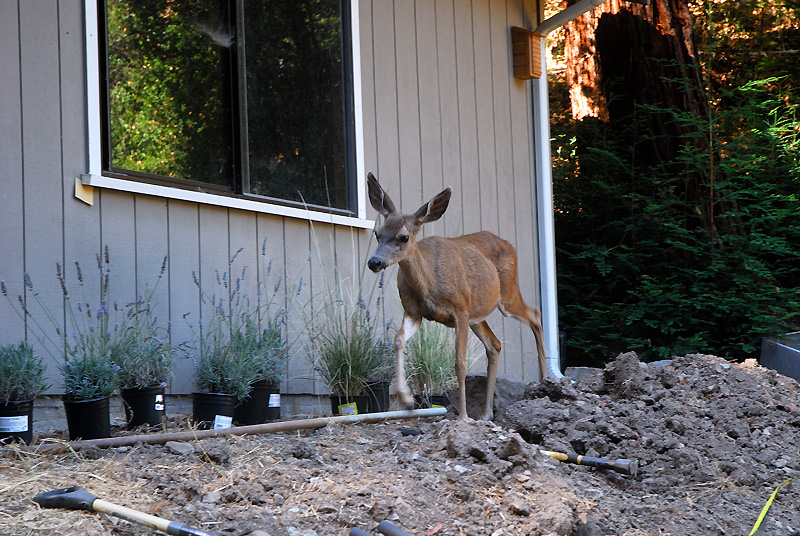
Just behind us, the buck, perhaps a sibling based on age, stood watching from behind the tractor.
At the end of October, the doe and her fawn managed to sneak into our hay storage when I accidentally left the doors open while I was in the goat barn. I came back and found them enjoying a large piece of alfalfa they’d stolen and dragged out into the driveway.

I probably should have chased her off, but then I noticed something strange with this doe’s right eye. As I got closer I could see she clearly had a cataract in that eye.
Her right eye was enlarged, and although she may have still been able to sense light and shadow, she wouldn’t be able to see much else through that eye. That could certainly increase her risk of predation, and it explained why I had managed to startle her on a few occasions, despite presuming she could see me standing there.
However, she seemed to be doing alright, a little thin perhaps, but with the drought, and a young fawn to feed, that didn’t seem particularly out of the ordinary at the time. I did make a point of closing the hay doors after that though, especially as good alfalfa was so difficult to find this season.
This encounter in October, however, turned out to be the last time I saw the doe, and I hadn’t seen her fawn either. Not until late last night.
For the last few days we’ve received a lot of much needed rain, and yesterday we were assaulted with numerous squalls and down-pours. We’ve been grateful for this rain, albeit wishing that perhaps the rains didn’t all come at once. However, our creeks are both now flowing again due to the run-off, the slopes are turning green again, the gardens look quite relieved, and our weeds are positively ecstatic!
Last night, in the rain, I went to the barn to milk the goats as usual. Same routine as always. I carried hay down to the barn, but as the deer haven’t been around I haven’t felt compelled to close the hay shed doors during evening chores. I was only gone for less than an hour. After milking, I carried the milk back up to the house, and went back to the hay shed to get some grass hay for the bucks.

By then it was starting to rain hard, so I dashed into the shed, and lept back after almost stepping on something in the dark, in the waste hay at the bottom of the stack. I shrieked slightly, and then backed up very slowly, and in the glow of my headlamp I saw this small doe curled up, soaking wet from the storm, and snuggled down in a deep pile of dry hay.
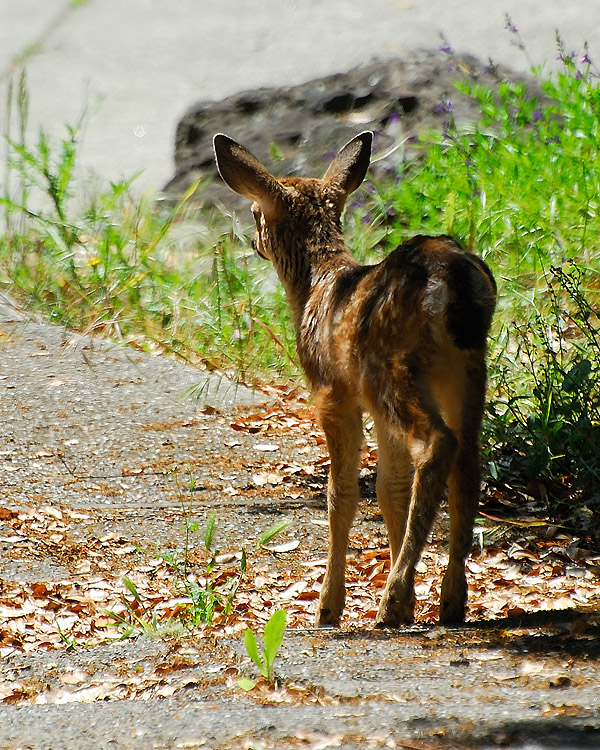
I was concerned, because even with as friendly as our deer have been on the farm, she didn’t startle, she just curled up tighter into a ball as I approached. I very carefully tip-toed by her, to get some hay for the bucks, and then just left her be. She’d stir, but didn’t seem overly compelled to leave. I feel quite strongly about not interfering with wildlife unless they clearly need assistance, so I elected to watch and wait, hoping she was just cold and worn out from the storm. She was certainly drenched, so I left her to sleep, warm herself, and dry off, even though I realized she may steal a snack of alfalfa when she awoke. I left the hay doors open all night so she was free to leave of her own accord once she had a chance to rest.
Just before dawn I went back to check to be sure she had moved on before closing the doors. At first I didn’t see her, but as I approached the door, I found her buried deeper in the hay this morning, stretched out, cold, and stiff. I was surprised to find that not only had she stayed in the shed last night, but that she now was clearly no longer with us. I just couldn’t believe she had suddenly showed up out of the blue, and within a few hours, died.
We removed her from the shed this morning, and I could feel she was emaciated. No wounds, no bleeding, but mere skin stretched over bone. If you enlarge the image above where she’s standing with her mother after stealing hay from the shed in October, you may notice that not only is she quite well-fleshed, but that she also had a small nick in her right ear. When I examined this doe this morning, she had that exact same distinguishing nick toward the tip of her ear. I wondered last night if this was the same young doe, but didn’t want to scare her, but this morning I had my answer. It was obvious that it was the daughter of the doe with the cataract that we’d watched grow up on the farm this summer, and I’m so sad that she didn’t even make it through her first autumn.
After not seeing her for weeks, I was surprised to see her last night. Although the rational side of my brain says she simply found an open door, and seized the opportunity to come in out of the torrential rain, any door, any shelter would suffice, a small part of me can’t help but wonder if after weeks of not being seen on the farm, if she intentionally sought out familiar surroundings last night. A place to rest, weak, and cold, because here she’d always felt safe, and trusted us. I’ll never have the answer to that question, but a small piece of me will always wonder.
More importantly, why this little doe was alone, and presumably separated from her mother for some time, we’ll never know. Perhaps her dam was run off during rut by a rambunctious buck, or succumbed to a predator, or injury?
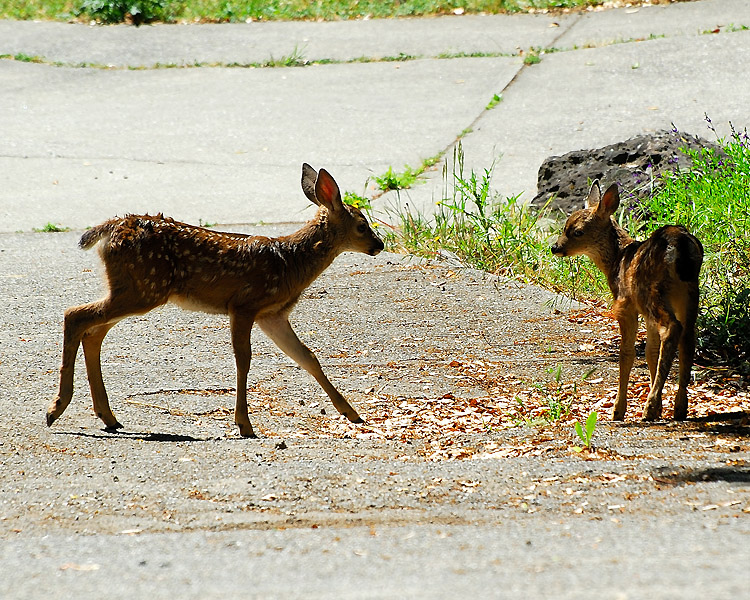
Perhaps the mountain lion I had a close encounter with last fall behind the buck pen is back in the area, or maybe her mother was hit by a car? We’ll never truly know. Nor do we know what became of the rest of her herd this year. A herd that just a few years ago was wreaking so much havoc in our orchard, breaking through fences, and tormenting fruit trees. The herd that on more than one occasion made us question if we could ever grow anything here.

This little one may have been disadvantaged by being born so late this season, when the grasses were already brown, water was scarce, and still being so small when our foul weather arrived in earnest this week. Sadly, in nature, life is a struggle, fraught with peril, and daily challenges, and although it sounds clichéd to say it, death is very much a part of life. I will miss her though, and greatly enjoyed watching her grow, and seemingly survive the odds this summer during the drought, and I’m grateful she chose to spend her last night here on the farm, where at least she was warm, safe, and dry. We buried her just after sunrise in the orchard this morning, to conceal her from scavengers, and discourage predators from lurking on the farm.
With so few surviving fawns the last few years, I’m not sure what spring will bring. Most of our once sizable herd now seems to have been lost to advancing age, and the younger does this year seem to have vanished. Even the bucks are scarce at the moment. It’s difficult to say if their decline in numbers is related to drought, disease, predation (human — and I do have my suspicions, or animal) or a combination of all of the above.
For the first time since we moved to the farm, it seems our orchard and gardens may have few, if any, deer to contend with, but the thought of that, and of perhaps not seeing fawns outside my office window next spring, honestly makes me quite sad. I can only hope that a new herd will soon fill this niche, and establish itself at Curbstone Valley again, but we’ll have to wait and see what spring will bring.

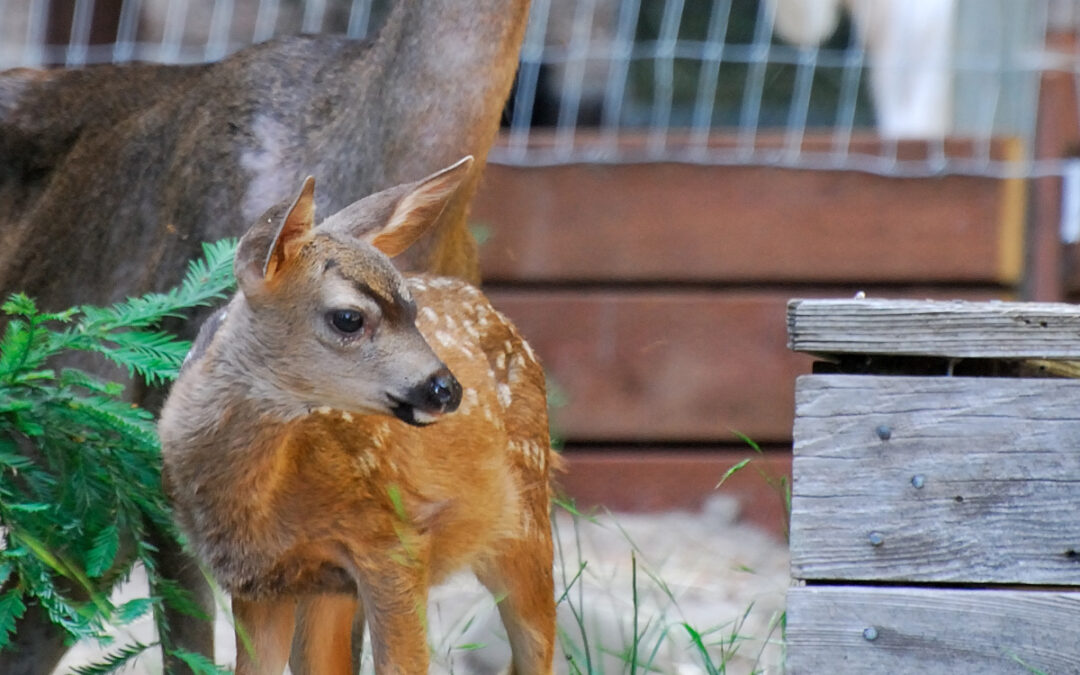

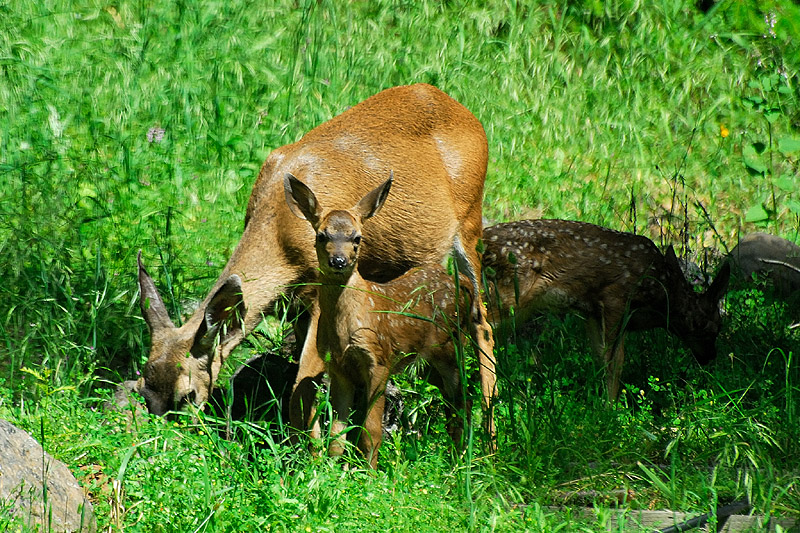
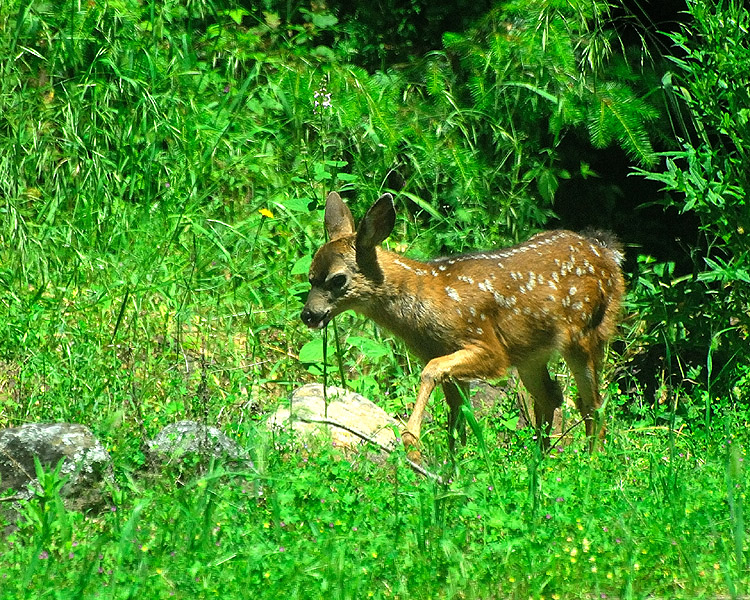



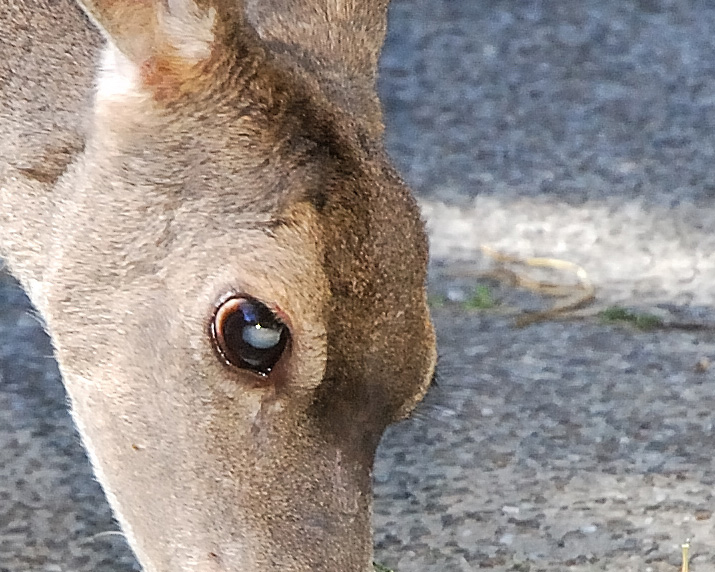
It’s hard not to think that there’s not a connection between the declining derr population and the increasing mountain lion population
I’ve wondered about that all season, after my first face-to-face with a mountain lion here a year ago last November. We certainly had presumed the converse was true when we first moved here. That with so many deer, it was unlikely that we had a lion in this immediate vicinity, especially as one buck that was here the first two years had a nasty, poorly healed broken hind leg. He was getting around, but clearly couldn’t outrun a large predator.
I suspect that the drought has a good deal to do with the declining deer population. Also, the changing climate seems to be making wildlife more susceptible to disease. Sad to lose your deer, pesky critters that they are to a gardener.
I expect the drought has had some role to play, but even here we’ve had plenty of forage all season due to the all of the understory wildland plants that grow here, like blackberry. Certainly water has been scarce, which I’m sure is why our fountain was popular this season. It just seems odd to me that so many of our adult deer have disappeared, and we’ve been left, for the first time ever, with not one, but TWO juveniles this season without their mothers 🙁
Awww, as much damage as they can do, deer are such beautiful, graceful creatures. It makes sense that drought, mountain lions, and other dangers combined could cause a dramatic decline in the deer population. What a touching story about your little doe, though. And sad but sweet that she picked your barn to make her exit from this life.
I do suspect a perfect storm of sorts. An aging herd, drought, fractured habitats, and apex predators. I think the little doe hit me especially hard because she seemed like the best hope for the future seasons here on the farm. Nature is, however, unscripted, and raw. I am glad she found somewhere dry, and secure, but I am very surprised she not only showed up here, in such a state of exhaustion/exposure, and yet managed to escape being predated on in the meantime. Nature will never cease to amaze me.
I believe the fawn *did* choose your farm as a friendly, safe resting place, so take comfort in that. A similar thing happened to me this summer with foxes — twice!
I never thought I’d say this, but I hope the deer make a comeback and start returning for you! (We have plenty of course)
Awww…I hopped over and found one of your fox posts from this summer. I don’t see red foxes here, although we do have an endemic species here, but I’ve never seen those either.
It does seem odd lamenting the absence of deer, when I’ve spent entirely too much time cursing them out in the past, but I do enjoy having them here. Hopefully our recent rains will translate into a good spring for the wildlife here on the farm 🙂
Aw, poor little thing! These things are probably somewhat cyclical, too, with predators and whatnot. As hard as deer can be on a garden, it would be hard not to love the sight of fawns frolicking in the area. I hope your drought is over and the wildlife can recover!
Looks like we’re not out of the drought woods yet, but we are getting rain, so that’s a huge step in the right direction! 🙂
Clare I would be sad if I didn’t see the fawns each summer here. Our herd seems to be smaller too or at least we have seen few….not many predators so I think maybe the cold is keeping them away.